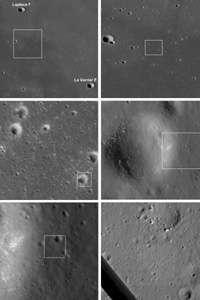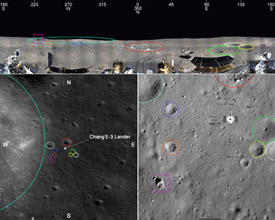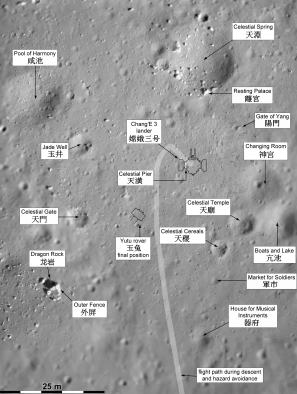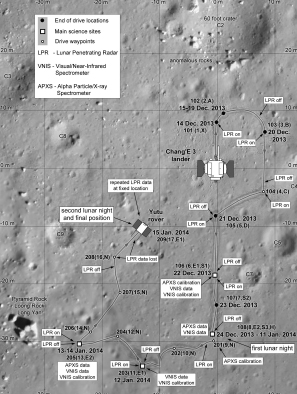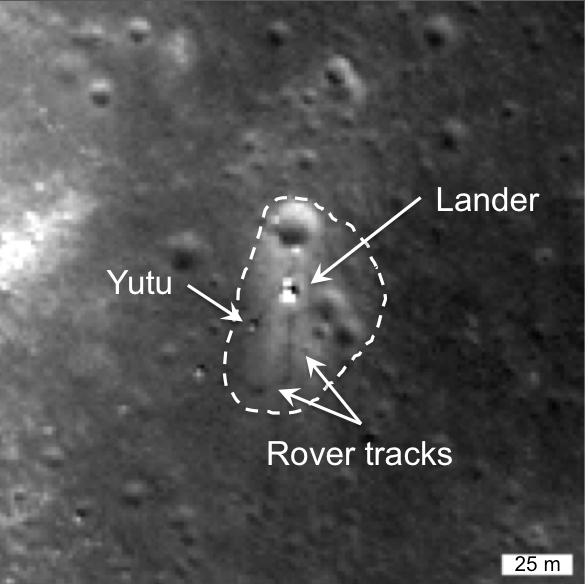Difference between revisions of "Chang'e-3"
| Line 2: | Line 2: | ||
=Chang’E-3= | =Chang’E-3= | ||
<div id="toc"> | <div id="toc"> | ||
| − | [[Image: | + | [[Image:Change3.jpg|change3.jpg]]<br /> Credit: Beijing Institute of Spacecraft Engineering<br /> <br /> |
==Description== | ==Description== | ||
Chang’E-3 was the first moon mission managed by the China National Space Administration ([http://www.cnsa.gov.cn/ CNSA]) to put a robotic rover on the lunar surface. Called ''‘Yutu’'' (translated as ‘Jade Rabbit’), the rover was deployed on to the lunar surface after the main Chang’E-3 lander autonomously soft-landed some ~ 40 km south of crater, Laplace F, on 14 December 2013. Weighing some 120 kilograms and coming in at 150 centimetres-high approximately, Yutu has four instruments onboard (four different on the lander, too): including a camera to take 3D imagery of the lunar terrain and its geological features, two spectrometers - a VNIS (visible and near-infrared) and APXS (alpha particle and x-ray) - to measure the lunar soil composition and distribution of various elements, and a radar for measuring soil depth and other structural features (e.g. layering etc.,) underneath.<br /> <br /> Those instruments onboard the lander during the mission were capable of carrying out further studies in imagery of the terrain, as well as observing earth’s ionosphere and other celestial objects in the clear, lunar sky above (both Yutu and the lander were also capable of ‘looking’ at each other on the surface).<br /> <br /> Chang’E-3 marks the first controlled, soft-landing moon mission in under four decades since last visited by the Luna 24, unmanned sample-return mission back in 1976. Future missions are planned (in a reverse-wise, Chang'E mission launch): Chang’E-5 is expected to be launched in 2019 for a sample return mission to the Nearside, while Chang’E-4 is expected to be launched sometime in 2018 on a mission to the Farside of the Moon involving a lander/rover/orbiter: (as of [https://www.chinaspaceflight.com/satellite/Deepspace/CE-4/CE-4.html 7 June 2017], the destination is to the southeast sector of [[Von%20Karman|Von Karman]] at 45.5S, 178.0E, which lies in the western sector of the [[South%20Pole%20Aitken%20Basin|South Pole Aitken Basin]]). In 2020, a permanent orbiting station is envisioned, in 2023 a sample-return mission to the Farside may occur, while in 2025 and 2027, landing missions at the lunar North and South Poles respectively are possible, too. Chang'E(?) mission numbers for each mission have yet to be announced.<br /> <br /> Cameras onboard NASA’s Lunar Reconnaissance Orbiter ([http://the-moon.us/wiki/LRO LRO])- currently orbiting the Moon - took close-up images of the Chang’E-3 landing site in late December, and future observations are planned. <span class="membersnap">- [http://www.wikispaces.com/user/view/JohnMoore2 [[Image:JohnMoore2-lg.jpg|16px|JohnMoore2]]] [http://www.wikispaces.com/user/view/JohnMoore2 JohnMoore2]</span><br /> <br /> | Chang’E-3 was the first moon mission managed by the China National Space Administration ([http://www.cnsa.gov.cn/ CNSA]) to put a robotic rover on the lunar surface. Called ''‘Yutu’'' (translated as ‘Jade Rabbit’), the rover was deployed on to the lunar surface after the main Chang’E-3 lander autonomously soft-landed some ~ 40 km south of crater, Laplace F, on 14 December 2013. Weighing some 120 kilograms and coming in at 150 centimetres-high approximately, Yutu has four instruments onboard (four different on the lander, too): including a camera to take 3D imagery of the lunar terrain and its geological features, two spectrometers - a VNIS (visible and near-infrared) and APXS (alpha particle and x-ray) - to measure the lunar soil composition and distribution of various elements, and a radar for measuring soil depth and other structural features (e.g. layering etc.,) underneath.<br /> <br /> Those instruments onboard the lander during the mission were capable of carrying out further studies in imagery of the terrain, as well as observing earth’s ionosphere and other celestial objects in the clear, lunar sky above (both Yutu and the lander were also capable of ‘looking’ at each other on the surface).<br /> <br /> Chang’E-3 marks the first controlled, soft-landing moon mission in under four decades since last visited by the Luna 24, unmanned sample-return mission back in 1976. Future missions are planned (in a reverse-wise, Chang'E mission launch): Chang’E-5 is expected to be launched in 2019 for a sample return mission to the Nearside, while Chang’E-4 is expected to be launched sometime in 2018 on a mission to the Farside of the Moon involving a lander/rover/orbiter: (as of [https://www.chinaspaceflight.com/satellite/Deepspace/CE-4/CE-4.html 7 June 2017], the destination is to the southeast sector of [[Von%20Karman|Von Karman]] at 45.5S, 178.0E, which lies in the western sector of the [[South%20Pole%20Aitken%20Basin|South Pole Aitken Basin]]). In 2020, a permanent orbiting station is envisioned, in 2023 a sample-return mission to the Farside may occur, while in 2025 and 2027, landing missions at the lunar North and South Poles respectively are possible, too. Chang'E(?) mission numbers for each mission have yet to be announced.<br /> <br /> Cameras onboard NASA’s Lunar Reconnaissance Orbiter ([http://the-moon.us/wiki/LRO LRO])- currently orbiting the Moon - took close-up images of the Chang’E-3 landing site in late December, and future observations are planned. <span class="membersnap">- [http://www.wikispaces.com/user/view/JohnMoore2 [[Image:JohnMoore2-lg.jpg|16px|JohnMoore2]]] [http://www.wikispaces.com/user/view/JohnMoore2 JohnMoore2]</span><br /> <br /> | ||
| Line 14: | Line 14: | ||
{| class="wiki_table" | {| class="wiki_table" | ||
| | | | ||
| − | [http://the-moon.us/wiki/file/detail/chang_e_3_landing_site_locator_map_post.jpg [[Image: | + | [http://the-moon.us/wiki/file/detail/chang_e_3_landing_site_locator_map_post.jpg [[Image:Chang_e_3_landing_site_locator_map_post-small.jpg|chang_e_3_landing_site_locator_map_post-small.jpg]]]<br /> |
| | | | ||
| − | [http://the-moon.us/wiki/file/detail/chang_e_3_site_mosaic2_post.jpg [[Image: | + | [http://the-moon.us/wiki/file/detail/chang_e_3_site_mosaic2_post.jpg [[Image:Chang_e_3_site_mosaic2_post-small.jpg|chang_e_3_site_mosaic2_post-small.jpg]]]<br /> |
|} | |} | ||
| Line 24: | Line 24: | ||
{| class="wiki_table" | {| class="wiki_table" | ||
| | | | ||
| − | [http://the-moon.us/wiki/file/detail/chang'e-3-pan-locations.jpg [[Image: | + | [http://the-moon.us/wiki/file/detail/chang'e-3-pan-locations.jpg [[Image:Chang%27e-3-pan-locations-small.jpg|chang'e-3-pan-locations-small.jpg]]]<br /> |
| | | | ||
| − | [http://the-moon.us/wiki/file/detail/chang-'e-3-panorama.jpg [[Image: | + | [http://the-moon.us/wiki/file/detail/chang-'e-3-panorama.jpg [[Image:Chang-%27e-3-panorama-small.jpg|chang-'e-3-panorama-small.jpg]]]<br /> |
|} | |} | ||
| Line 32: | Line 32: | ||
{| class="wiki_table" | {| class="wiki_table" | ||
| | | | ||
| − | [[Image: | + | [[Image:Rock1.jpg|rock1.jpg]]<br /> |
|} | |} | ||
| Line 44: | Line 44: | ||
{| class="wiki_table" | {| class="wiki_table" | ||
| | | | ||
| − | [http://the-moon.us/wiki/file/detail/chang_e_3_yutu_map1.jpg [[Image: | + | [http://the-moon.us/wiki/file/detail/chang_e_3_yutu_map1.jpg [[Image:Chang_e_3_yutu_map1-small.jpg|chang_e_3_yutu_map1-small.jpg]]]<br /> |
| | | | ||
| − | [http://the-moon.us/wiki/file/detail/chang_e_3_yutu_map2.jpg [[Image: | + | [http://the-moon.us/wiki/file/detail/chang_e_3_yutu_map2.jpg [[Image:Chang_e_3_yutu_map2-small.jpg|chang_e_3_yutu_map2-small.jpg]]]<br /> |
|} | |} | ||
Revision as of 01:44, 16 April 2018
Contents
Chang’E-3
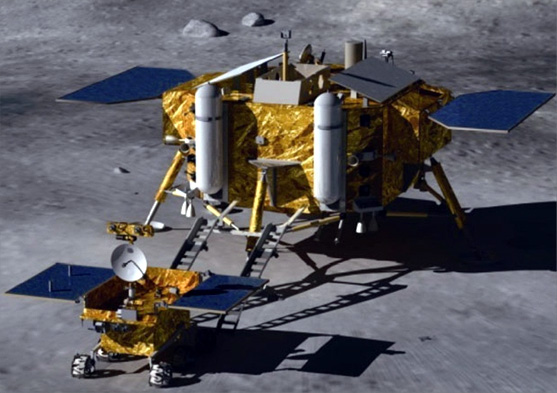
Credit: Beijing Institute of Spacecraft Engineering
Description
Chang’E-3 was the first moon mission managed by the China National Space Administration (CNSA) to put a robotic rover on the lunar surface. Called ‘Yutu’ (translated as ‘Jade Rabbit’), the rover was deployed on to the lunar surface after the main Chang’E-3 lander autonomously soft-landed some ~ 40 km south of crater, Laplace F, on 14 December 2013. Weighing some 120 kilograms and coming in at 150 centimetres-high approximately, Yutu has four instruments onboard (four different on the lander, too): including a camera to take 3D imagery of the lunar terrain and its geological features, two spectrometers - a VNIS (visible and near-infrared) and APXS (alpha particle and x-ray) - to measure the lunar soil composition and distribution of various elements, and a radar for measuring soil depth and other structural features (e.g. layering etc.,) underneath.
Those instruments onboard the lander during the mission were capable of carrying out further studies in imagery of the terrain, as well as observing earth’s ionosphere and other celestial objects in the clear, lunar sky above (both Yutu and the lander were also capable of ‘looking’ at each other on the surface).
Chang’E-3 marks the first controlled, soft-landing moon mission in under four decades since last visited by the Luna 24, unmanned sample-return mission back in 1976. Future missions are planned (in a reverse-wise, Chang'E mission launch): Chang’E-5 is expected to be launched in 2019 for a sample return mission to the Nearside, while Chang’E-4 is expected to be launched sometime in 2018 on a mission to the Farside of the Moon involving a lander/rover/orbiter: (as of 7 June 2017, the destination is to the southeast sector of Von Karman at 45.5S, 178.0E, which lies in the western sector of the South Pole Aitken Basin). In 2020, a permanent orbiting station is envisioned, in 2023 a sample-return mission to the Farside may occur, while in 2025 and 2027, landing missions at the lunar North and South Poles respectively are possible, too. Chang'E(?) mission numbers for each mission have yet to be announced.
Cameras onboard NASA’s Lunar Reconnaissance Orbiter (LRO)- currently orbiting the Moon - took close-up images of the Chang’E-3 landing site in late December, and future observations are planned. - JohnMoore2 JohnMoore2
Additional Information
- Launched from the Xichang Satellite Launch site in southwest China on 2 December 2013 (1.30 am Beijing local time, 12:30 pm EST on 1 December 2013 EST) atop a Long March 3B rocket.
- Entered lunar orbit on 6 December 2013.
- LADEE will be observing the dust and gaseous effects that Chang’E-3 will have on the lunar atmospheric environment.
- Lander: Overall dry mass = 1200 kilograms. Body rests ~ 0.83 metres above the surface. Landing legs span ~ 5 metres. Powered by solar panels and a 239-Plutonium Dioxide Radioisotope Thermoelectric Generator.
- Rover: Overall 120 kilograms in weight (carries a payload mass of 20 kilograms). Six individually-powered wheels (with rocker-bogie suspension). Powered by solar panels (with possible Radioisotope Heater Units). Slope toleration ~ 20 degrees, and capable of driving over obstacles ~ 20 centimetres. Total driving distance – expected up to 10 kilometres.
- Images below (left group) show the approximate location of the Chang’E-3 landing site compiled by Phil Stooke using LROC imagery and live images taken by a camera onboard Chang’E-3, while (right group) shows a recent December 2013 LROC before and after comparison view.
- (click on image for larger views)- JohnMoore2 JohnMoore2
- Images below
Left: Annotated, colour-adjusted version of the Chinese Academy of Sciences' panoramic image (seen to the right). The top-most image of the annotated version shows the approximate location markers for each feature seen in the highly-resolved panoramic view, the bottom-left image shows a LROC aerial view of the region, while the bottom right image shows the approximate rover route map, constructed by Phil Stooke.
Right: Full resolution (4.8 Mbytes), panoramic view from the Chang’E-3 lander - constructed by the team of scientists and engineers of the Chinese Academy of Sciences.
- (click on images for larger views)- JohnMoore2 JohnMoore2
- Images above.
Left: Approximate rover route map, constructed by Phil Stooke.
Right: Close-up of the rock (see pink square added in the original route map for location purposes) taken by the Yutu rover that deployed from the Chang’E-3 lander (see also Xiao, L. reference in bibliography). Image colour-adjusted, credit is to CNSA. - JohnMoore2 JohnMoore2
- On 5 Oct 2015, the IAU approved the name Guang Han Gong for the Chang'E 3 landing site, as well as approving three nearby craters - Tai Wei, Zi Wei and Tian Shi.- JohnMoore2 JohnMoore2
- Images below (January 2016 update) of Change'E-3/Yutu route maps. Maps supplied courtesy of Phil Stooke.
Left: Shows names (with Chinese characters) in reference to local features and names.
Right: Shows scientific operations (with dates) during Yutu's exploration of the area traversed.
- (click on images for larger views)- JohnMoore2 JohnMoore2
- Image below (May 2016 update) of Change'E-3/Yutu/Lander locations.
- (click on image for larger view)- JohnMoore2 JohnMoore2
LROC Articles
(note: while searching on the LROC site, one should try Chang'e 3 and also Chang'e-3 to get all the articles!).
- Article number 637: Chang'e 3 Lander and Rover from Above
- Article number 718: A Great Place to Rove!
- Article number 724: Safe on the Surface of the Moon!
- Article number 751: Still There!
- Article number 811: The Chang'e 3 Landing Site in 3D
- Article number 813: Casting a Long Shadow
- Article number 929: What a Blast! - Revisiting the Chang'e 3 Landing Site
LPOD Articles
APOD Articles
- Lunar Time Lapse Panorama including Yutu Rover
- Yutu Rover Rolls onto the Moon
- Yutu on a Little Planet (nadir centered fish-eye view of the landingsite of Chang'e 3).
Bibliography
- Clegg-Watkins, R. N. et al (2016). Photometric characterization of the Chang’e-3 landing site using LROC NAC images - Icarus Vol 273, 15 July 2016.
- Long, X. et al (2016). Major scientific objectives and candidate landing sites suggested for future lunar explorations – SCIENTIA SINICA Physica, Mechanica & Astronomica 46(2), 029602 (2016); 21 - 25 March 2016.
- Ling, Z. C. et al (2016). DIFFERENTIATION OF BASALTIC LAVA AT CHANG'E-3 LANDING SITE – 47th Lunar and Planetary Science Conference 21 - 25 March 2016.
- Fa, W. (2016) EJECTA PROPERTIES OF ZI WEI CRATER AS REVEALED BY CHANG’E-3 LUNAR PENETRATINGRADAR. – 47th Lunar and Planetary Science Conference 21 - 25 March 2016.
- Ling, Z. C. et al (2016). USE OF RADIATIVE-TRANSFER MODELING TO ESTIMATE NANOPHASE IRON ABUNDANCE AT THE CHANG'E-3 SITE. – 47th Lunar and Planetary Science Conference 21 - 25 March 2016.
- Zongcheng, L. et al (2015). Correlated Compositional and Mineralogical Investigations at the Chang′e-3 Landing Site – Nature Communications Article number: 8880, doi:10.1038/ncomms9880. Published 22 December, 2015.
- Li, C. et al (2015).The Chang'E-3 Mission Overview – Space Science Reviews v. 190, pp. 85-101. 2015.
- Wang, J. et al (2015). 18-Months Operation of Lunar-based Ultraviolet Telescope: A Highly Stable Photometric Performance - arXiv:1510.01435 [astro-ph.IM], 6 Oct, 2015.
- Xiao, L et al (2015). A young multilayered terrane of the northern Mare Imbrium revealed by Chang’E-3 mission. - Science Vol. 347 no. 6227 pp. 1226-1229 DOI: 10.1126/science.1259866. 13 March 2015.
- Special Issue on Chang’e-3 (2014). Research in Astronomy and Astrophysics – Vol 14, No 12, December 2014.
- Qiao, L. et al (2014). Geological Features and evolution history of sinus Iridum, the moon – Planetary and Space Science - Vol 7 No 5, DOI: 10.1016/j.pss.2014.06.007. Published Online 25 June 2014.
- Xiao, L. (2014). China’s Touch on the Moon. Nature Geoscience, Volume:7, Pages:391–392. DOI: 10.1038/ngeo2175. Published online 29 May 2014.
- Shuwu, D. et al (2014). Chang’E-3 Lunar Rover’s Scientific Payloads – Chinese Journal of Space , Vol. 34, Issue (3): 332-340 DOI: 10.11728/cjss2014.03.332. 15 April 2014.
- Robinson, M. S., Plescia, J. B., Wagner, R. V. (2014) Imaging of the Chang’E 3 Landing Site – 45th Lunar and Planetary Science Conference 17 - 21 March 2014.
- ZHAO JianNan. et al (2014). Geologic Characteristics of the Chang’E-3 Exploration Region - SCIENCE CHINA Physics, Mechanics and Astronomy. Published online 21 Jan, 2014.
- Preliminary Science Results from Chang'E-3 on Lunar Networks, 16 Jan, 2014.
- Zhang Jiayu, Wang Huanyu, Zhang Chengmo 等 (2013). Thermal Control Design and Simulation Calculation of the Alpha Particle X-ray Spectrometer - Chinese Journal of Space Science, 33(6): 672-677. 2013.
